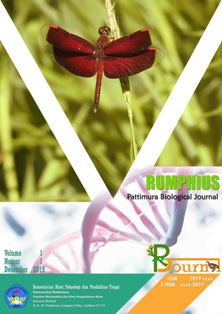DYNAMICS COMMUNITIES OF BACTERIA AND YEAST IN PROCESSING ROBUSTA COFFEE WITH WET PROCESSING: SCREENING OF DOMINANT ISOLATES
Abstract
The type of coffee processing has a direct impact on the microbial community it contains and the quality of the coffee it produces. Coffee processing with a wet process (wet) is known to produce coffee with a good aroma and taste profile. This study aims to determine the dynamics of the bacterial and yeast community during the postharvest process and to determine the dominant microbes involved in the processing of Robusta coffee using a wet process. The method used was the isolation of bacteria and yeast using selective medium with the addition of antibiotics, then morphological identification and calculation of the index of diversity (H), dominance (D) and evenness (E) were carried out based on the bacterial and yeast isolates obtained, as well as screening of dominant isolates based on results of dominance analysis and enzymatic activity. The isolation results obtained by the yeast community (51.7%) with a higher number than the bacterial community (48.3%). The microbial community in the wet processing of Robusta coffee had a species diversity index (H') = 2.48, evenness (E) = 0.74 and dominance (D) = 0.17. The results of isolates screening through enzymatic tests showed bacterial isolates B10 and yeast Y2 were selected as dominant isolates and could be used as starter cultures in a controlled fermentation process.
Downloads
References
Berutu, M. A. C. 2017. Isolation of Pectinase-Producing Microbes and Optimization of Their Production in Purifying Apple Juice (Malus Domestica). Thesis. Bogor Agricultural Institute.
Capuccino, J. G., and Sherman, N. 2008. Microbiology: A Laboratory Manual 8th Edition. Pearson: Sans Francisco.
Carrasco M., Villarreal P., Barahona S., Alcaíno J., Cifuentes V., and Baeza M. 2016. Screening and Characterization of Amylase and Cellulase Activities in Psychrotolerant Yeasts. BMC Microbiology. 16(21): 1-9. doi:10.1186/s12866-016-0640-8.
Evangelista S. R., Miguel P. D. G. M., Silva C. F., Pinheiro A. C. M., and Schwan R. F. 2015. Haile M., and Kang W. H. 2019. The Role of Microbes in Coffee Fermentation and Their Impact on Coffee Quality. Journal of Food Quality. 2019: 1-6. doi:10.1155/2019/4836709.
Hidayat I. 2004. Bacillus sp Enzyme Activity Screening. which is isolated from the Gunung Halimun National Park. Biology News. 7(1): 25-32.
Microbiological diversity associated with the spontaneous wet method of coffee fermentation. International Journal of Food Microbiology. 210: 102–112. doi:10.1016/j.ijfoodmicro.2015.06.008.
Magguran A. E. 1988. Ecological Diversity and its Measurement. London: Chapman and Hall.
Mawazin and Subiakto A. 2013. Diversity and Composition of Natural Regeneration Types of Logged Peat Swamp Forests in Riau. Indonesian Forest Rehabilitation Journal. 1(1): 59-73.
Moradi M., Shariati P., Tabandeh F., Yakhchali B., and Khaniki B. G. 2014. Screening and Isolation of Powerful Amylolytic Bacterial Strains. International Journal of Current Microbiology and Applied Sciences. 3(2): 758-768.
Novalia D., Yuanita S. P., Wikandari R. P. 2014. Screening for Thermophilic Proteolytic Bacteria from Singgahan Tuban Hot Springs. UNESA Journal of Chemistry. 3(3): 49-54.
Nusaly N.W. 2020. Standardization of Fermentation in Robusta Coffee Honey Production with Variations in Inoculum Comparison and Fermentation Time Length. Master's Program Thesis. Bandung Institute of Technology.
Pereira D. V. G., Soccol T. V., Pandey A., Medeiros P. B. A., Lara A. R. M. J., Gollo L. A., and Soccol S. R. 2014. Isolation, Selection and Evaluation of Yeasts for Use in Fermentation of Coffee Beans by the Wet Process. International Journal of Food Microbiology. 188(2014): 60-66. doi:10.1016/j.ijfoodmicro.2014.07.008.
Pereira D. V. G., Neto D. P. D., Júnior M. I. A., Vásquez S. Z., Medeiros P. B. A., Vandenberghe S. P. L., and Soccol R. C. 2018. Exploring the Impacts of Postharvest Processing on the Aroma Formation of Coffee Beans – A review. Food Chemistry. 272: 441-452. doi:10.1016/j.foodchem.2018.08.061.
Indonesian Coffee and Cocoa Research Center. 2008: Superior Clones of Robusta Coffee and Several Choices of Clone Composition Based on Environmental Conditions. Jember: Indonesian Coffee and Cocoa Research Center.
Ritonga H. I. 2018. Isolation and Identification of Gram Negative Bacteria from Soil Samples at the People's Animal Husbandry School (SPR), Muara Enim Regency, South Sumatra. Thesis. Bogor Agricultural Institute.
Rodarte P. M., Dias R. D., Vilela M. D., and Schwan F. R. 2011. Proteolytic Activities of Bacteria, Yeasts and Filamentous Fungi Isolated from Coffee Fruit (Coffea Arabica L.). Acta Scientiarum Agronomy. 33(3): 457-464. doi:10.4025/actasciagron.v33i3.6734
Syachnoormalieta F. I. 2018. Optimization of Wine Coffee Fermentation Using Varying Comparisons and Percentage of Inoculum Amount. Master's Program Thesis. Bandung Institute of Technology.
Sulistyani H. T., Rahayuningsih M., and Partaya. 2014. Diversity of Butterfly Types (Lepidoptera: Rhopalocera) in the Ulolanang Kecubung Nature Reserve, Batang Regency. Unnes Journal of Life Science. 3(1): 9-17.
Widowati E., Utami R., Nurhartadi E., Andriani M. A. M., and Hanifah R. 2014. Production and Characterization of Pectinase Enzyme for Pectinolytic Bacteria from Orange Peel Waste for Clarification of Lemon Juice (Citrus Limon). Journal of Agricultural Products Technology. 7(1): 20-25.
Wulandari P. T., Sukmawati D., and Kurniati H. T. 2017. Isolation and selection of amylolytic yeast from jackfruit (Artocarpus Heterophyllus Lam.). Biomes. 13(1): 37-42. doi:0.21009/Bioma13(1).5.
Authors who propose a manuscript and have it approved for publication know that the manuscript will be registered and become part of the RPBJ. Authors and readers understand that this journal is open and all its contents can be accessed freely, provided that RPBJ is still listed as the source of information. The hope is that this journal can become a vehicle for exchange and scientific knowledge for society and the scientific community, especially in the field of Biology and other branches of science.









